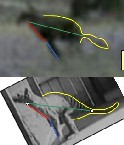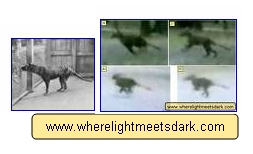Doyle thylacine
In 1973, Gary and Liz Doyle captured approximately 10 seconds of film footage of an animal running across the road in front of them in mainland South Australia.
Whilst the presently-available film quality is poor, many have analysed it and speculated that it depicts a thylacine.
Where Light Meets Dark's first analysis of the Doyle footage was published in 2006 and at that time the whereabouts of the original footage was unknown. In 2017 contact was made with Liz Doyle who confirmed she still has the original 8mm film.
| Article | Notes | |
|---|---|---|
| Backstory and initial analysis | This first analysis examines 69 still frames of the Doyle footage. A number of thylacine anatomical features are considered, and frames counted depicting these. Archive-footage still-frames are used for comparison. A further 32 still-frames of a running greyhound are analysed and finally the body proportions of the animal in the Doyle footage are compared to those of a thylacine in 1930s archive footage. | |
| High resolution analysis | This second analysis uses a higher resolution version of the footage. Properties of the MPEG file format are examined and very important conclusions are drawn about artefacts which appear in the film. Specifically, the animal's apparent stripes are considered in detail. Archive footage of a 1930s thylacine is used as a cross-reference. | |
| Comparison with a known thylacine | Two frames of the Doyle footage are compared with one frame from footage created by David Fleay of a known thylacine. The relative proportions of numerous body features are compared and discussed in detail. | |
| Enhanced-quality footage analysed | A digitally restored version of the Doyle footage has been received. Seven frames are presented and key thylacine diagnostic features including the hind foot length, hindquarters shape, chest depth and tail are highlighted and compared with multiple frames taken from known thylacine footage captured by David Fleay. The earlier conclusion that the apparent striping on the Doyle animal is due to artefacts introduced by the mpeg technology is revoked - this author now believes the apparent striping is due to colouration on the animal itself (which may or may not be striping). |



